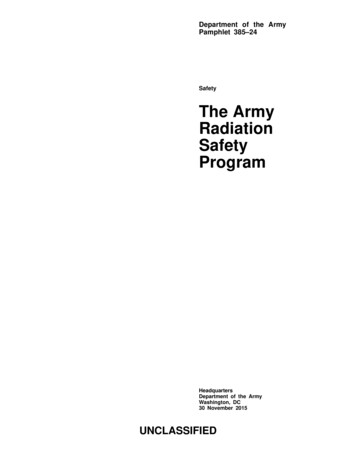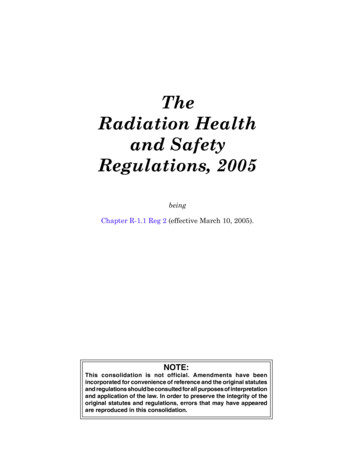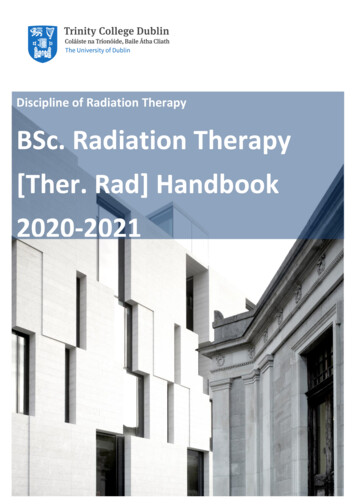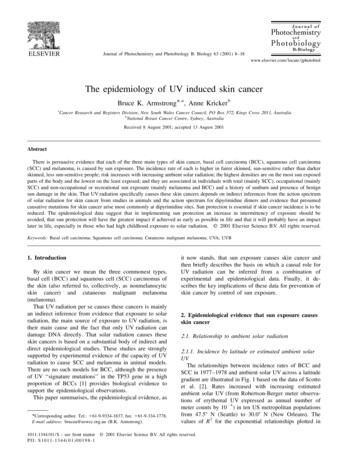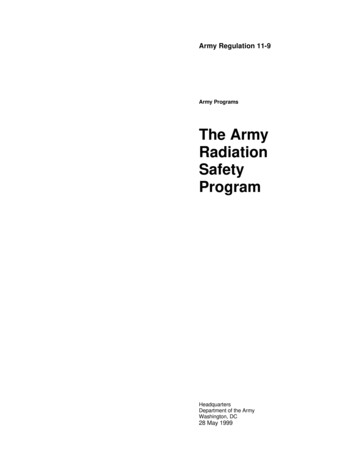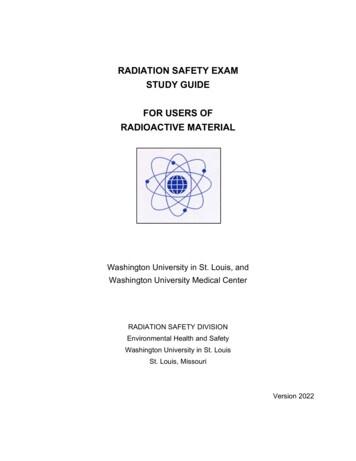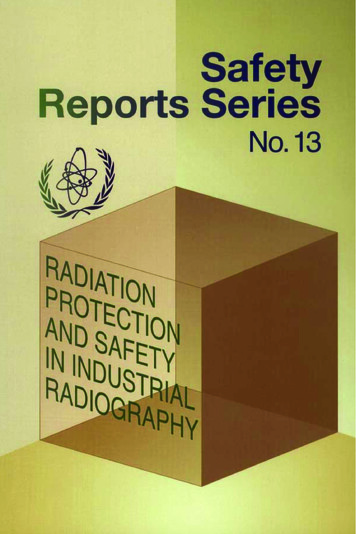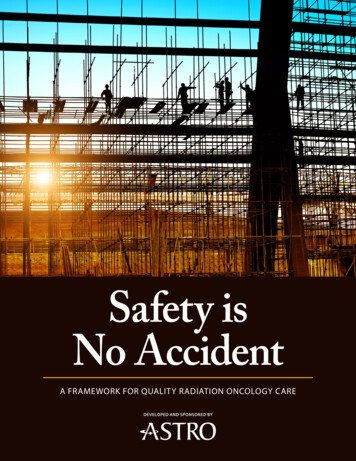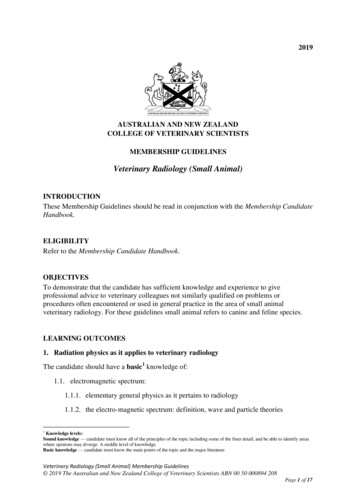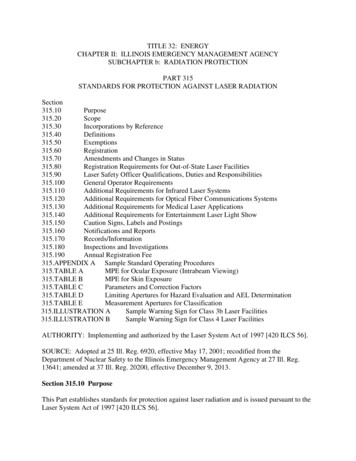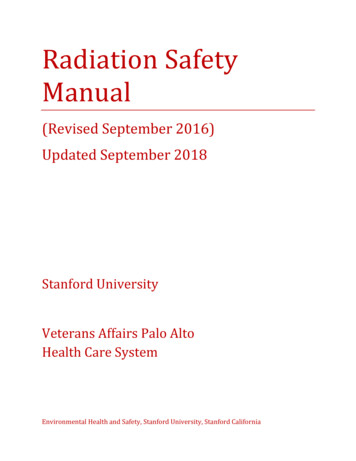
Transcription
RADIATION SAFETY POLICY MANUALPrepared and issued under the auspices ofTHE RADIATION SAFETY COMMITTEEJune 1996For additional information, contactTHE RADIATION SAFETY OFFICERRadiological Health Department260 S Central Campus Drive, Room 100581-6141
ForewordIonizing radiation provides the Un iversity comm unity with a powerful tool formedicine and research. The beneficial applications of radiation continue to grow asscientists delve ever further into the workings of our bodies, our environment and ouruniverse. In add ition to the benefits derived from the use of radiation, however, there arerisks that m ust be recognized and controlled. The assessment and man agement of theserisks is, itself, a scientific discipline that provides the basis for the contents of this manual.The responsibility for establishing radiation protection policies and for authorizingthe use of specific radiation sources at the University of Utah is delegated to the RadiationSafety Com mittee. This Radiation Safety Policy Manual contains the general policies andprocedures adopted by the Committee for the safe use of ionizing radiation in teaching,research and clinical medicine. Additional procedures containing detailed instructions forspecific sources or categories of use are available from the Committee through the RadiationSafety Officer. A uthorization for the use of any licen sed or registered radiation source isconditional upon complete compliance with federal and state regulations, license conditionsand with the policies and procedures promulgated by the Radiation Safety Comm ittee.Although the use of radiation sources is governed by complex regulations and licenseconditions, the knowledge and performance required of individu al radiation users is readilycomprehended and accomplished. It is the responsibility of each individ ual w ho w orks w ithsources of ionizing radiation to know and follow the policies and procedures promulgatedby the Radiation Safety Comm ittee and administered by the Radiation S afety Officer.Raymond F. Gesteland, Ph.D.Vice President for ResearchDistinguished Professor, Geneticsi
THIS PAGE INTENTIONALLY LEFT BLANKii
TABLE OF CONTENTSForew ord . . . . . . . . . . . . . . . . . . . . . . . . . . . . . . . . . . . . . . . . . . . . . . . . . . . . . . . . . . . . . . . . . . . . . . . . . . . . . . . IPURPOSE . . . . . . . . . . . . . . . . . . . . . . . . . . . . . . . . . . . . . . . . . . . . . . . . . . . . . . . . . . . . . . . . . . . . . . . . . . . . . 1EMERGENCY PROCEDURES . . . . . . . . . . . . . . . . . . . . . . . . . . . . . . . . . . . . . . . . . . . . . . . . . . . . . . . . . . . .Radiation Emergency . . . . . . . . . . . . . . . . . . . . . . . . . . . . . . . . . . . . . . . . . . . . . . . . . . . . . . . . . . . . . . . . .Responsibilities . . . . . . . . . . . . . . . . . . . . . . . . . . . . . . . . . . . . . . . . . . . . . . . . . . . . . . . . . . . . . . . . . . . . .Emergency Telephone Nu mbers . . . . . . . . . . . . . . . . . . . . . . . . . . . . . . . . . . . . . . . . . . . . . . . . . . . . . . . .1111BASIS FOR RADIATION PROTECTION POLICIES . . . . . . . . . . . . . . . . . . . . . . . . . . . . . . . . . . . . . . . . . .Radiation-Induced H ealth Effects . . . . . . . . . . . . . . . . . . . . . . . . . . . . . . . . . . . . . . . . . . . . . . . . . . . . . . .Principles of Radiation Protection . . . . . . . . . . . . . . . . . . . . . . . . . . . . . . . . . . . . . . . . . . . . . . . . . . . . . . .Radiation D ose - Quantities and U nits . . . . . . . . . . . . . . . . . . . . . . . . . . . . . . . . . . . . . . . . . . . . . . . . . . .Radiation Doses and Risks . . . . . . . . . . . . . . . . . . . . . . . . . . . . . . . . . . . . . . . . . . . . . . . . . . . . . . . . . . . .Individu al Dose Limits . . . . . . . . . . . . . . . . . . . . . . . . . . . . . . . . . . . . . . . . . . . . . . . . . . . . . . . . . . . . . . .ALA RA Policy . . . . . . . . . . . . . . . . . . . . . . . . . . . . . . . . . . . . . . . . . . . . . . . . . . . . . . . . . . . . . . . . . . . . .2333344RESPONSIBILITIES . . . . . . . . . . . . . . . . . . . . . . . . . . . . . . . . . . . . . . . . . . . . . . . . . . . . . . . . . . . . . . . . . . . .Radiation Safety Officer . . . . . . . . . . . . . . . . . . . . . . . . . . . . . . . . . . . . . . . . . . . . . . . . . . . . . . . . . . . . . .Radiation Safety Comm ittee . . . . . . . . . . . . . . . . . . . . . . . . . . . . . . . . . . . . . . . . . . . . . . . . . . . . . . . . . . .Radioactive Drug Research Committee . . . . . . . . . . . . . . . . . . . . . . . . . . . . . . . . . . . . . . . . . . . . . . . . . . .Nuclear Reactor Safety Committee . . . . . . . . . . . . . . . . . . . . . . . . . . . . . . . . . . . . . . . . . . . . . . . . . . . . . .Radiation Users . . . . . . . . . . . . . . . . . . . . . . . . . . . . . . . . . . . . . . . . . . . . . . . . . . . . . . . . . . . . . . . . . . . . .Qualified User . . . . . . . . . . . . . . . . . . . . . . . . . . . . . . . . . . . . . . . . . . . . . . . . . . . . . . . . . . . . . . . . . . . . . .Responsible User . . . . . . . . . . . . . . . . . . . . . . . . . . . . . . . . . . . . . . . . . . . . . . . . . . . . . . . . . . . . . . . . . . . .Radiological Health Department . . . . . . . . . . . . . . . . . . . . . . . . . . . . . . . . . . . . . . . . . . . . . . . . . . . . . . . .456677778ACQUISITION OF RADIATION SOURCES . . . . . . . . . . . . . . . . . . . . . . . . . . . . . . . . . . . . . . . . . . . . . . . . .Radioactive M aterials . . . . . . . . . . . . . . . . . . . . . . . . . . . . . . . . . . . . . . . . . . . . . . . . . . . . . . . . . . . . . . . .Analytical X-ray Machines . . . . . . . . . . . . . . . . . . . . . . . . . . . . . . . . . . . . . . . . . . . . . . . . . . . . . . . . . . . .Self-shielded Irradiators . . . . . . . . . . . . . . . . . . . . . . . . . . . . . . . . . . . . . . . . . . . . . . . . . . . . . . . . . . . . . . .Particle Accelerators . . . . . . . . . . . . . . . . . . . . . . . . . . . . . . . . . . . . . . . . . . . . . . . . . . . . . . . . . . . . . . . . .88999RADIATION SAFETY TRAINING . . . . . . . . . . . . . . . . . . . . . . . . . . . . . . . . . . . . . . . . . . . . . . . . . . . . . . . . . 9CONTROL AND MON ITORING OF EXPOSURES TO EXTERNAL RADIATION SOURCES . . . . . . .Safety Evaluations . . . . . . . . . . . . . . . . . . . . . . . . . . . . . . . . . . . . . . . . . . . . . . . . . . . . . . . . . . . . . . . . . .Medical X-ray Units . . . . . . . . . . . . . . . . . . . . . . . . . . . . . . . . . . . . . . . . . . . . . . . . . . . . . . . . . . . . . . . .Radioactive M aterials . . . . . . . . . . . . . . . . . . . . . . . . . . . . . . . . . . . . . . . . . . . . . . . . . . . . . . . . . . . . . . .Exposure Evaluation and Monitoring . . . . . . . . . . . . . . . . . . . . . . . . . . . . . . . . . . . . . . . . . . . . . . . . . . .Personal Dosimeters (Badges) . . . . . . . . . . . . . . . . . . . . . . . . . . . . . . . . . . . . . . . . . . . . . . . . . . . . . . . . .Investigation Levels . . . . . . . . . . . . . . . . . . . . . . . . . . . . . . . . . . . . . . . . . . . . . . . . . . . . . . . . . . . . . . . . .iii10101010101011
TABLE OF CONTENTS(Continued)CONTROL AND MON ITORING OF INTAKE OF RADIOISOTOPES . . . . . . . . . . . . . . . . . . . . . . . . . . . .Handling Precautions . . . . . . . . . . . . . . . . . . . . . . . . . . . . . . . . . . . . . . . . . . . . . . . . . . . . . . . . . . . . . . . .Contamination Surveys . . . . . . . . . . . . . . . . . . . . . . . . . . . . . . . . . . . . . . . . . . . . . . . . . . . . . . . . . . . . . .Airborne A ctivity . . . . . . . . . . . . . . . . . . . . . . . . . . . . . . . . . . . . . . . . . . . . . . . . . . . . . . . . . . . . . . . . . . .Bioassays . . . . . . . . . . . . . . . . . . . . . . . . . . . . . . . . . . . . . . . . . . . . . . . . . . . . . . . . . . . . . . . . . . . . . . . . .Thyroid Protection . . . . . . . . . . . . . . . . . . . . . . . . . . . . . . . . . . . . . . . . . . . . . . . . . . . . . . . . . . . . . . . . . .111212121213PERSONAL EXPOSURE INVESTIGATIONS AND REPORTING . . . . . . . . . . . . . . . . . . . . . . . . . . . . . . . 13REIMBURSEMENTS AND FEES . . . . . . . . . . . . . . . . . . . . . . . . . . . . . . . . . . . . . . . . . . . . . . . . . . . . . . . . .Extraordinary C osts . . . . . . . . . . . . . . . . . . . . . . . . . . . . . . . . . . . . . . . . . . . . . . . . . . . . . . . . . . . . . . . . .Optional Services . . . . . . . . . . . . . . . . . . . . . . . . . . . . . . . . . . . . . . . . . . . . . . . . . . . . . . . . . . . . . . . . . . .Incentive Fees or Fines . . . . . . . . . . . . . . . . . . . . . . . . . . . . . . . . . . . . . . . . . . . . . . . . . . . . . . . . . . . . . . .13141414LABORATORY EVALUATIONS; SURVEYS AND AUDITS . . . . . . . . . . . . . . . . . . . . . . . . . . . . . . . . . . 14SEALED SOURCE LEAK TESTS . . . . . . . . . . . . . . . . . . . . . . . . . . . . . . . . . . . . . . . . . . . . . . . . . . . . . . . . . 15CALIBRATION OF INSTRUMENTS . . . . . . . . . . . . . . . . . . . . . . . . . . . . . . . . . . . . . . . . . . . . . . . . . . . . . . 15TRAN SPORT ATION AN D SHIPMEN T OF RA DIOACTIVE M ATER IALS . . . . . . . . . . . . . . . . . . . . . . . 15RADIOACTIVE WASTE MANAGEMENT . . . . . . . . . . . . . . . . . . . . . . . . . . . . . . . . . . . . . . . . . . . . . . . . . 16BIBLIOGRAPHY . . . . . . . . . . . . . . . . . . . . . . . . . . . . . . . . . . . . . . . . . . . . . . . . . . . . . . . . . . . . . . . . . . . . . . 17GLOSSARY . . . . . . . . . . . . . . . . . . . . . . . . . . . . . . . . . . . . . . . . . . . . . . . . . . . . . . . . . . . . . . . . . . . . . . . . . . . 19iv
RADIATION SAFETY POLICY MANUALPURPOSEThis manual conveys the official policies of the Universityof Utah for the control of all sources of, and exposures to,ionizing radiation that are within the jurisdiction of theUniversity. The manual defines responsibilities ofindividu als and organizations for rad iation control, itspecifies the policies that guide specific decisions onradiation control matters, and it provides general safetyrules and procedures that are obligatory for all users ofradiation sources. Additional requirements and proceduresnot included in this manual are developed, promulgatedand enforced as necessary to implement the overallphilosophy and policies for radiation protection as presented herein.Federal and state regulations require a written radiationprotection program that includes provisions for keepingdoses as low as reasonably achievable (ALARA). Allradiation users shall be included in the program and shallbe informed of the program and of their individualresponsibilities. This manual is intended to satisfy theseregulatory requirements.EMERGENCY PROCEDURESRad iation Em ergencyAny accident, injury or loss of control of a radiation sourcethat could cause an excessive or uncontrolled radiationexposure to any individual is referred to as a radiationemergency. The proper response to any radiationemergency depends upon a thorough understanding of themagnitude of risks, priorities for action and the applicationof common sense. Each user of radiation sources sh ouldbe familiar with the basic emergency responses listedbelow and methods for applying them in his or her ownwork area. Detailed instructions for coping with radiationemergencies are prepared only for a few special facilitiesand a few categories of emergen cy response personnel.The "Emergency Guide" in the front of the Campus Directory provides general instructions on what to do in variouskinds of emergency situations.Respon sibilitiesThe Public Safety Department is responsible for overallemergency response communication and coordination.The notification of appropriate response personnel andestablishment of necessary communications links duringemergencies are services provided by Public Safety.The Radiation Safety Officer (RSO) is responsible forproviding technical guidance and assistan ce on allemergencies involving or potentially involving radioactivity or radiation exposures. The Radiological HealthDepartment shall be notified promptly of all accidentsor incidents involving radiation sources at the Universityof Utah. M embers of the Radiological Health Departm entare authorized to act on behalf of the RSO and providethe staff and facilities to deal with radiation emergencies.RADIATION EMERGENCYNOTIFICATION & ASSISTANCEAmbulance; Fire DepartmentUniversity Police9-911585-2677Radiological Health Department &Rad iation Safety Officer581-6141(Calls are forwarded to the Un iversityPolice Dispatcher at night or onweekends)MEDICAL RADIATIONEMERGENCIESUniversity HospitalEmergency Department581-2291(Ask for the Charge Nurse or theAttending Physician and specify"Medical radiation emergency")Responsib le users of radiation sources are responsiblefor clean up of spilled m aterials and for assuring that allindividuals within their jurisdiction comply with monitoring and reporting requirements established by the RSO.RA DIA TIO N S AF ET Y P OL ICY MAN UA L (6 /96) - Page 1
Facilities or groups with unique radiation emergencyresponse requirements shall maintain and use detailedemergency procedures applicable to their needs.Close the sash on fume hoods, but do not turn offhood ex haust fans.Close doors to the area and post signs or guards toprevent unauthorized entry.Protect People!The first consideration in any emergency is to assistinjured persons and to prevent any further injury. Formedical assistance, dial 9-911 immediately and report thenature of the illness or injury. If the person may becontaminated with radioactive material, inform the 911dispatcher of the situation. If you are qualified to renderfirst aid, do so without regard to the presence of radioactivity. There are no radiation sources at theUniversity that produce radiation exposure risks largeenough to preven t giving first aid! Except for the usualprecautions for moving an injured person, individu alsshould immediately leave the room or area until the extentof the radiological hazard has been evaluated. However,all individuals should remain available in the vicinity untilchecked for contamination or exposure.Get Help!Each individu al usin g radiation sources sh ould know inadvance who to call in case of a radiation emergency. Iffire, injury or other emergency conditions in addition toradiation are involved, first call the appropriate num berslisted in the front of the Campus Directory. Then call theRadiological Health Department (1-6141) during normaloffice hours; or call the University Police (5-2677) duringoff-duty hours.Wh en reporting any emergency, be sure to state the exactnature of the emergency; then give your name and thephone number from which you are calling, the exactlocation of the em ergency (building, room, nearestentrance, etc.) and the nam e of the Responsible U ser, ifknown. Do not hang up! Let the person called end theconversation after all pertinent information is clearlyunderstood.Contain the Hazard!Any of the following actions appropriate to the situationshould be performed provided they can be carried outsafely:Allow no one to leave the area without being checkedfor contamination.Follow-up ActionIf required by the Radiation Safety Officer (RSO),individuals involved in a radiation emergency shall submitspecimens for bioassay, surrender personal clothing orother articles for decontamination or assay, and providepertinent information. Any necessary decontaminationor repairs required after a radiation emergency shall beperformed only under the direction of the Radiation SafetyOfficer (R SO ).Re-entry or re-occupancy must be authorized by the RSO.The RSO shall evaluate, record and report, as necessary,any radiation exposures to personn el, loss of radioactivematerial, or damage to radiation facilities resulting fromthe emergency.The Vice President for Research is the official spokesmanfor the University on matters pertaining to radiation protection. Individuals involved in radiation emergencies shouldrefrain from discussing the event with anyone other thanUn iversity officials until after a complete evaluation hasbeen made.BASIS FOR RADIATION PROTECTIONPOLICIESIonizing radiation is capable of producing biologicaleffects that are detrimental to health. It is assumed thatany radiation dose, no matter how small, could producesome effect. The purpose of a radiation safety programis to prevent unnecessary radiation exposures, and tocontrol th ose that are necessary.Cover containers of radioactive materials.Each person who is knowingly exposed to ionizingradiation from sources controlled by the Un iversity shallbe informed of the risks and of appropriate protectionmethods, and shall accept personal responsibility for usingthe available protection.Place absorben t material on spilled liquids.Radiation-Induced H ealth EffectsRA DIA TIO N S AF ET Y P OL ICY MAN UA L (6 /96) - Page 2
Health effects from exposure to ion izing radiation maybe stochastic (random in an exposed population) ordeterministic (predictable for an individual).Determ inistic effects may be ob served in an exposed individual when a large radiation dose, exceeding a threshold value, is received in a rather short time. A dosesmaller than the threshold value will not produce theeffect. If threshold dose for a particular effect is exceeded,the effect is almost sure to occur, but the severity of theeffect is proportional to the dose.Stocha stic effects are those that occur randomly in anexposed population, usually after a long latent period.Since these effects cannot be distinguished from those thatoccur in an unexposed population, the cause-and-effectrelation ship cannot be established on an individual basis,but only on a statistical basis. For these effects it isassumed that there is no threshold dose and that theprobability of occurrence is proportional to the dose.However, the severity of the effect, if it occurs, isindependent of the dose.Principles of Radiation ProtectionTwo basic principles ap ply to every individual that maybe exposed to radiation: (1) all radiation doses are to bekept as low as reasonably achievable (ALARA),and (2)no dose to an individu al shall be allowed to exceed theappropriate individual dose lim it.The ALAR A p rincip le is applicable even when thepotential dose is well below the individual dose limitbecause it is assumed that some risk may be associatedwith any dose of radiation, no matter how small. ALARAalso means balancing the benefits of dose reduction againstsocial needs and economic considerations.Dose limits are intended to limit the individual's lifetimerisk of stochastic effects from small chronic exposures aswell as to prevent non-stochastic effects from large doses.For individuals who are exposed to ionizing radiation asa direct result of their employment, individual dose limitsare based on the philosoph y that their total health risksshould be no greater than the risks accepted by workersin comparable occupations or industries who are notexposed to radiation.For anyone who does not receive a direct benefit, e.g. asalary, related to their radiation exposure, the individualdose limits are much smaller than those for radiation users.These "non-occupational" limits are based on comparisonswith the ordinary risks of living, rather than on risks dueto employm ent.Radiation Dose - Q uantity and UnitsRadiation dose limits are specified as a quantity called theeffective dose equivalent in units of rems. The effectivedose equivalent is the dose to the whole body frompenetrating x rays that would impart the same lifetime riskof detrimental health effects as the sum of the actual dosesto all tissues an d organs of the body from all types ofionizing radiation. (See the Glossary for a more detailed,technical discussion of this quantity and the includedadjustment factors.) The Un iversity expresses all dosesand limits in millirems (1 mrem 0.001 rem). Throughoutthe rest of this Manu al, unless otherwise clearly specified,"dose" means "effective dose equivalent".Radiation Doses and RisksThe doses and related health risks produced by nonoccupational radiation exposures may be helpful for understanding the risks from occup ational doses. In the U.S.,the annual average dose from cosmic rays and othernatural sources is 100 mrem, the effective dose from radonin homes is 200 mrem, medical examinations contributean average of 53 mrem and consum er products and othermanmade sources deliver another 9 mrem, for a total ofapproximately 360 mrem per year. In Utah, because ofincreased cosm ic radiation and greater concentrations ofradioactive minerals in the ground, the average annualdose is more than 400 m rem.The risk of fatal cancer from all causes, averaged over theentire U.S . pop ulation, is ap proximately 1 in 4, or 25%.It is recognized, however, that certain sub-groups, e.g.smokers or residents of large cities, have cancer risks thatare above average, while other groups have risks that arebelow the average. For most stochastic effects, a givendose of radiation is believed to increase the baseline riskfor a population group by a constant fraction or proportion.A continuous dose rate of 400 mrem per year for 70 yearsis estimated to contribute approximately 1.5% to thebaseline risk of fatal cancer. The majority of radiationusers receive occupational doses of much less than 400mrem per year. An additional dose of 400 mrem per yearfor 20 years w ould increase the baseline risk for fatalcancer by 0.3%.RA DIA TIO N S AF ET Y P OL ICY MAN UA L (6 /96) - Page 3
Individual Dose LimitsThe primary occupational dose limit is 5,000 millirem sper year, effective dose equivalent.The dose limit for mem bers of the general pub lic, including all persons who are not classified as radiationusers, is 100 millirem s per year. No person shall be classified as a radiation user simply to justify a higher doselimit.The embryo-fetus may be more susceptible to radiationeffects than an adult and is, therefore, subject to a lowerdose limit. The dose limit for the embryo-fetus is 500millirem s during the entire gestation period. As afurther precaution, it is advisable to keep the month lydoses below 50 millirems. This degree of protection forthe embryo-fetus can only be achieved with the cooperation of the employee, who should notify hersupervisor as soon as the pregnancy is known. The limitis enforceable on ly if the pregnant employee gives writtennotice to her supervisor, who shall also notify the RSO.ALAR A Po licyThe Un iversity is committed to an effective radiationprotection program to eliminate unnecessary exposuresto radiation and to reduce all exp osures to levels that areas low as reasonably achievable (ALARA), taking intoaccount all social and economic considerations. TheALARA principle is a formal requirement of the U.S.Nuclear Regulatory Commission and the Utah Departmentof Environmental Quality.The ALARA principle is implemented by a comprehensiveradiation protection program that includes specific requirements and procedu res for:1 training of all radiation users,2 safety evaluation s of proposed facilities or projectsutilizing radiation in any way,3 regular surveys of work areas for contamination andexposure rates,4 monitoring of radiation exposures to groups andindividuals,5 investigations of all exposures that exceed predetermined levels, and6 audits of the program by the Radiation SafetyCom mittee and/or other qualified experts.Each facility or program utilizing radiation machines orradioactive materials shall be justified on its merits andshall be sp ecifically authorized by the Radiation SafetyComm ittee. The review and evaluation by the Committeecovers the training and experience of individu alsauthorized to use radiation sources, the adequacy of facilities and equipment, and procedures for the safe use ofradiation sources.Specific rules and procedures may be issued by theRadiation Safety Officer (RSO) in support of the ALARAconcept as well as to assure compliance with all legal andregulatory requirements. The RSO and supp orting staffprovide training, consultation and other services to radiation users to assist them in controlling radiation sourcesand redu cing exposures.RESPONSIBILITIESThe possession and use of radioactive materials and othersources of ionizing radiation are governed by regulationsof several federal and state agencies, and by conditionsof specific licenses issued to the University. The Boardof Regents delegates authority to the President of theUn iversity who appoints and em powers the organizationsand individuals described below to develop , maintain andadminister an effective program for radiation protection.The University permits the use of ionizing radiationsources for beneficial applications in teaching, research,medicine and community service when such sources areacquired and used in accordance with the policies,principles and rules contained in this manual. Theprotection of the health and welfare of each memb er ofthe faculty, staff, student body and general public is ofprimary importance; however, the financial, legal andsocietal obligations of the University are also consideredin the imp lementation of practical radiation protectionpractices.Rules and procedures promulgated for use within theUn iversity shall comply with the regulations andrequ irements of the federal and state agencies that licenseand regulate radiation sources and uses.Technical assessments, evaluations and interpretationsshall also be consistent with the guidance and recommendations of authoritative advisory bodies, such as theInternational Commission on Radiological Protection, theNational Council on Radiation Protection and Measurements, and the American National Standards Institute.RA DIA TIO N S AF ET Y P OL ICY MAN UA L (6 /96) - Page 4
Radiation Safety Officer (RSO)The Radiation Safety Officer (RSO ) is the individualspecifically appointed by the U niversity, and named onthe radioactive materials licenses, to establish and enforcesuch procedures as are necessary to assure compliancewith applicable regulations and license conditions, andto ensure effective implementation of the policies and rulesestablished by the Radiation Safety Committee.Depending on th e context, "RSO" m ay also refer toany individual specifically designated to act on beh alfof, and under the supervision of, the RSO.The RSO is authorized and directed to promulgate andenforce such proced ures as are necessary to assurecompliance with applicable federal and state regulationsand to ensure the accurate interpretation and effectiveimplementation of the policies and rules established bythe Radiation Safety Comm ittee. The RS O is authorizedto terminate immediately any project or operation thatpresents a radiological threat to health or property.Actions to restrict the acquisition of radioisotopes or theuse of any radiation source, for the purpose of enforcingcompliance with radiation protection regulations orprocedures shall be initiated only by the RSO. Theaffected user may appeal the action to the Radiation S afetyCommittee or to the Vice President for Research.The RSO shall establish radiation exposure investigationlevels and, if those levels are exceeded, initiate a promptinvestigation of the cause of the exposure and aconsideration of actions that might be taken to reduce theprobability of recurrence.The RS O is responsible for:1maintaining copies of pertinent regulations, licenseapplications, licenses and amendm ents;2maintaining all records of the acquisition, use anddisposition of radiation sources within the jurisdictionof the University;3maintaining records of radiation monitoring andsurveillance related to exposures of individuals fromUniversity controlled sources; and4providing instruction and services to radiation usersfor the safe and authorized use of radiation.With respect to the use of radioactive materials, the RSOis responsible for investigating spills, losses, thefts, unauthorized receip ts, use s, tran sfers, d ispo sals,misadministrations, and other deviations from approvedradiation safety practice and implementing correctiveactions as necessary.The RSO reports to the Vice President for Research onadm inistrative matters and to the Radiation S afetyComm ittee on technical matters. The RSO receivesdirection from the RSC with regard to policy and providestechnical advice to the Committee, radiation users and theadministration. At least annually, the RSO shall briefmanagement on the radiation protection program.Radiation Safety Committee (RSC)The Radiation Safety Comm ittee (RSC) is the governingbody for all aspects of radiation protection within theUniversity, including all affiliated research, clinical,instructional and service units utilizing radiation sourcesin facilities owned or controlled by the Un iversity. TheRSC will ensu re that all possession, use and dispositionof radiation sources by University personnel complies withpertinent federal and state regulations and with the specificconditions of licenses issued to the University, and thatall concomitant radiation exposures are maintainedALARA.The RSC is composed of individu als who represent thevarious uses of radiation w ithin the U niversity and areknowledgeable and experienced in the safe use of radiationsources, as well as individu als represen ting variousadministrative and service functions. Representatives ofthe nursing service and of U niversity management arerequired on the Committee. The RSO is an ex officiomember of the Comm ittee. The C ommittee is requiredto meet at least once during each calendar quarter.The RSC is empowered and directed to prom ulgatepolicies, rules and procedures for the safe use of radiationsources. The RS C is respon sible for assuring that onlyqualified indivi
Univer sity. The manual defines responsibilities of individuals and organizations for radiation control, it specifies the policies that guide specific decisions on radiation control matters, and it provides general safety rules and procedures that are obligatory for all users of radiation sources. Add iti onal req uirem ents and proced ure s
